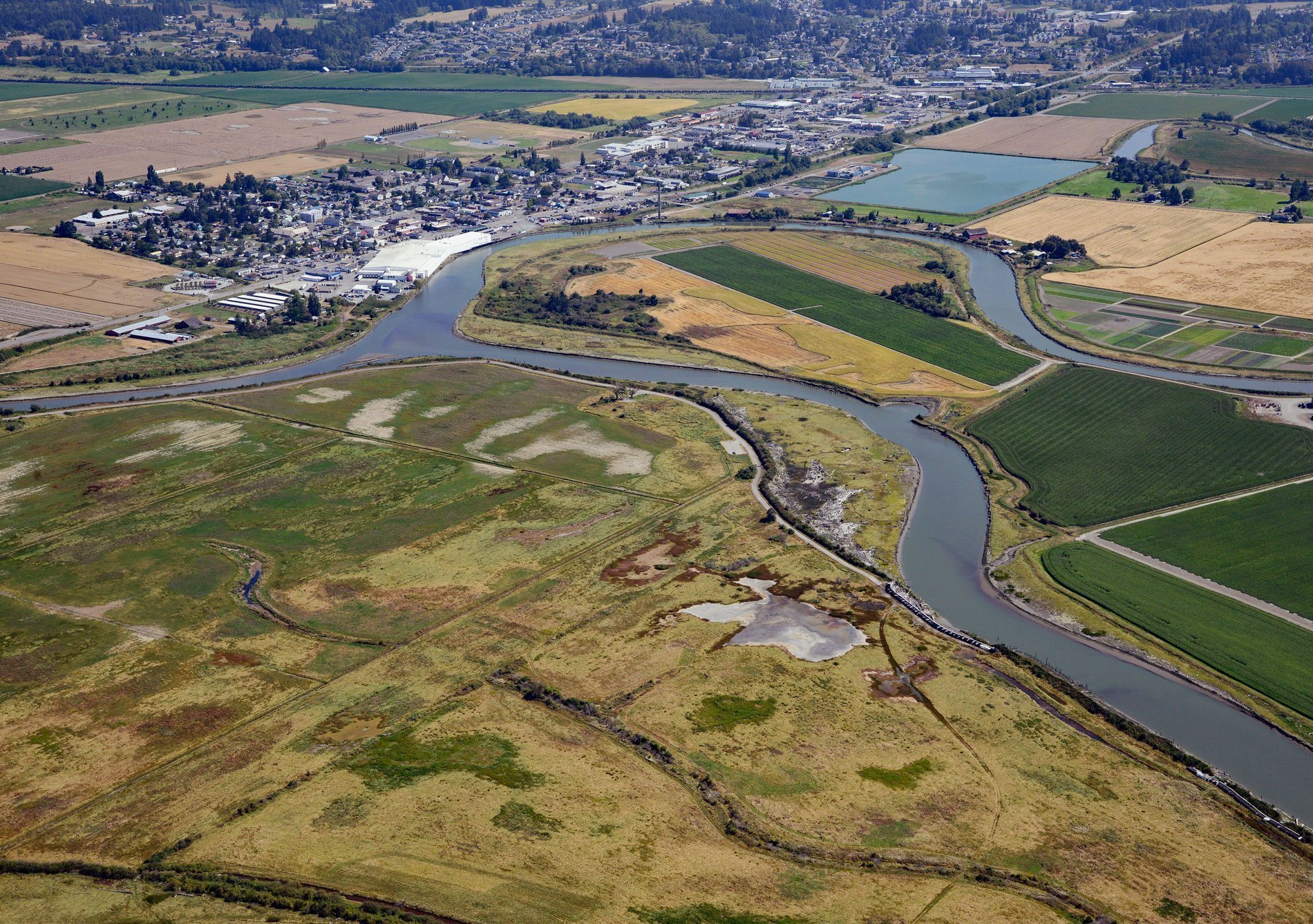Leque Island is located at the mouth of the Stillaguamish River on South Pass channel that separates Camano Island from the mainland, about 43 miles (69 km) north of Seattle and 0.6 miles (1 km) southwest of Stanwood, Washington. The island is named after Nels P. Leque who settled here in 1876 when the island was a tidal salt marsh bisected by a slough used by Natives in canoes as a shortcut between Davis Slough and West Pass. The underlying bedrock is of Miocene age and is covered by 1,000 to 3,100 feet (305-945 m) of glacial and nonglacial sediment. The nutrient-rich soil on Leque Island was deposited as a lahar, a violent type of mudflow, that flowed down the river valley from a Glacier Peak eruption about 12,500 years ago. The salt marsh deposits are mostly silt and clay, commonly with lenses and layers of peat and other organic material originally deposited in salt water or a brackish marsh environment. Many of these deposits have been converted to agricultural use by the construction of levees. Repeated flooding by the Stillaguamish River continues to deposit nutrients and sediment.
Archaeological evidence indicates that humans began living here about 6,000 years ago. The tribes of the Coast Salish people inhabited the Skagit River delta and were closely associated with tribes of the Upper Skagit River. The Stillaguamish people camped on neighboring Camano Island and in 1792, villages were observed by Captain George Vancouver and Lieutenant Joseph Whidbey as they explored Puget Sound. In the mid-1800s, a few adventurous Euro-Americans found their way to the Washington Territory and entrepreneurial lumbermen found the tall Douglas fir trees on Camano Island. The trees were first cut for use as ship spars and wharf pilings, and most were loaded on sailing ships for transport to San Francisco or foreign ports. In 1856, a sawmill was built in Utsalady Bay on Camano Island when Leque Island was a tidal area with about 400 acres (162 ha) of salt marsh and 100 acres (40 ha) cluttered with logs and debris. In the early 1870s, Jerome N. Barry and his brother set up a camp at the south end of the island for a logging operation. In 1876, a Norwegian immigrant named Oliver B. Iverson partnered with Nils Eide, Nels P. Leque, and Andy Danielson to begin farming on Leque Island. They diked and drained the island, then grew oats and hay, and pastured cattle. These families farmed the land of Leque Island for several generations, eventually selling the parcels off to other farmers. Since 1974, the Washington State Department of Fish and Wildlife has purchased 325 acres (132 ha) of the island and contracted farmers to plant grains for wintering waterfowl. More recently Leque Island had suffered repeated dike failures which have prompted restoration efforts.
In 2007, the Port Susan Marine Stewardship Area was established, encompassing the entire Port Susan Bay including the shoreline and Leque Island. The stewardship is managed by a number of environmental groups and works towards improving the health of the waters around the island. The changes in the estuaries and marshes on Leque Island, carried out to promote agriculture, such as diking and draining were identified as one of the threats to the marine ecosystem. In 1974, the Washington Department of Fish and Wildlife began acquiring properties on Leque Island and now owns the entire island. The Leque Island Estuary Restoration Project was initiated with Ducks Unlimited, the Stillaguamish Tribe, The Nature Conservancy, and Skagit River System Cooperative and in 2019 the project removed over 2.4 miles (3.8 km) of a levee and restored 250 acres (101 ha) of tidal marsh, an important habitat for juvenile Chinook salmon and shorebirds. Since dike removal, 15 different species have been found using the restored area including juvenile Chinook, chum, and coho salmon, and adult bull trout. Read more here and here. Explore more of Leque Island here:

